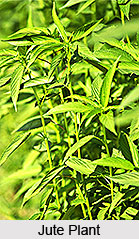 Jute is one of the most important cash crops of eastern India. Jute is used for manufacturing carpets, rugs, tarpaulins, upholstery, ropes and strings. Jute belongs to the family of Chorchorus. There are two species which are cultivated in India ---- Chorchorus capsularis or white jute and Chorchorus olitorius or toss jute.
Jute is one of the most important cash crops of eastern India. Jute is used for manufacturing carpets, rugs, tarpaulins, upholstery, ropes and strings. Jute belongs to the family of Chorchorus. There are two species which are cultivated in India ---- Chorchorus capsularis or white jute and Chorchorus olitorius or toss jute.
Jute Plant in India
The height of Jute Plant ranges from 2 to 4 metres. Since Chorchorus capsularis is highly adaptable, it covers nearly 75 % of the cultivated area. Chorchorus olitorius, which cannot withstand floods, is grown only on uplands. Jute is an annual type plant. It appears spear-like with round stems a little thicker than a man`s finger and scarcely has any branches except at the top. The fibre in the inner bark is soft and strong and allows good lengths to be drawn out.
The jute plant requires high temperature with a minimum of 27 degree centigrade and an optimum of about 34 degree centigrade during the period of growth. The relative humidity requirement is also high ranging from 80 to 90 percent. During the growing period, the jute plant needs an evenly distributed rainfall of 170 cm to 200 cm.
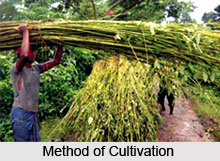 Sandy and clayey loams are perfectly beneficial for the growth of this plant. It grows well on the alluvial soil found in the flood plains and deltas of rivers.
Sandy and clayey loams are perfectly beneficial for the growth of this plant. It grows well on the alluvial soil found in the flood plains and deltas of rivers.
Method of cultivation
Sowing
The sowing of Chorchorus capsularis starts with the rains in March and April and continues till early June. Seeds are either broadcast or dropped in shallow furrows. In recent years, the cultivators have started practising line sowing with the help of drills. In the early stages, weeding is absolutely necessary. Destroying the weeds between rows with wheel-hoe saves labour and helps to mulch the soil.
Harvesting
The plant takes four to six months to mature. The appearance of the flower is the sign that the harvesting process needs to begin. Harvesting begins in July and ends in September. The plants are cut close to the ground level or uprooted in case the ground is flooded. A small portion of the crops is left for maturing into seeds.
Processing
The harvested plants remain in the field for 2 to 3 days for the leaves to shed. Then they are tied into bundles, each with a diameter of about 20 to 25 cm.
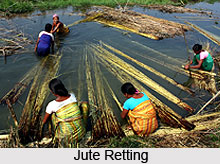 Retting
Retting
Retting is a microbiological process which loosens the outer bark and facilitates removal of the fibre from the stalk. From the tenth day the cultivator starts inspecting a few plants. If the fibre smoothly slips out when pressure is applied with the thumb, retting is considered to be complete. Ten or twelve reeds at a time are beaten with a mallet to loosen the fibre which is then washed in clean water, wrung and spread out in the sun for drying up. The fibre is then sorted into bundles, according to the quality and pressed into bales. Plenty of clean water is required for all the processes. Removing the fibre from the plant and preparing it for the jute mills requires large supply of labour.
Yield
The yield of jute per hectare varies from state to state. The average yield is about 1300 kg per hectare. The yield can be increased by using improved seeds, applying fertilizers, and adopting better plant protection measures.
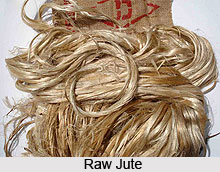 Areas of Poduction
Areas of Poduction
West Bengal comes first in the production of raw jute. The main jute growing districts are Murshidabad, West Dinajpur, Cooch Behar district, Nadia district, Burdwan, Malda district and Midnapore. In Bihar the important jute producing districts are Purnea, Katihar diatrict, Saharsa district and Darbhanga district. In Assam, the cultivation of jute is concentrated along the Brahmaputra River and Surma river valleys in the districts of Kamrup, Goalpara, Darrang district, Tezpur, Sibsagar and Nowgong. Production of jute also occurs in Uttar Pradesh, Orissa, Tripura and Meghalaya.
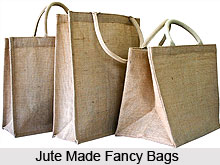 Uses of Jute in India
Uses of Jute in India
Jute uses comprise containers for planting young trees which can be planted directly with the containers without disturbing the roots and land restoration where jute cloth prevents erosion occurring while natural vegetation become established.
Jute is largely used as raw materials for packaging textiles, non-textiles, construction & agricultural sector. Besides packaging ,wrapping or backing fabrics, jute has variety of usage e.g. ropes/twines, geotextile, decorative fabrics, upholsteries & furnishing fabrics, woven carpets, mats, webbing, soft luggage, fancy bags, composite etc.
Jute is the most affordable natural fibres and is second only to cotton in amount produced & variety of uses. Jute delivers lasting solution to the universal problem of pollution. Jute is nature friendly because its contents are cellulose & lignin which are bio degradable. Jute also does not generate toxic gases when burnt. It is a renewable natural fibre which makes no demand on the worlds scarce energy resources.















